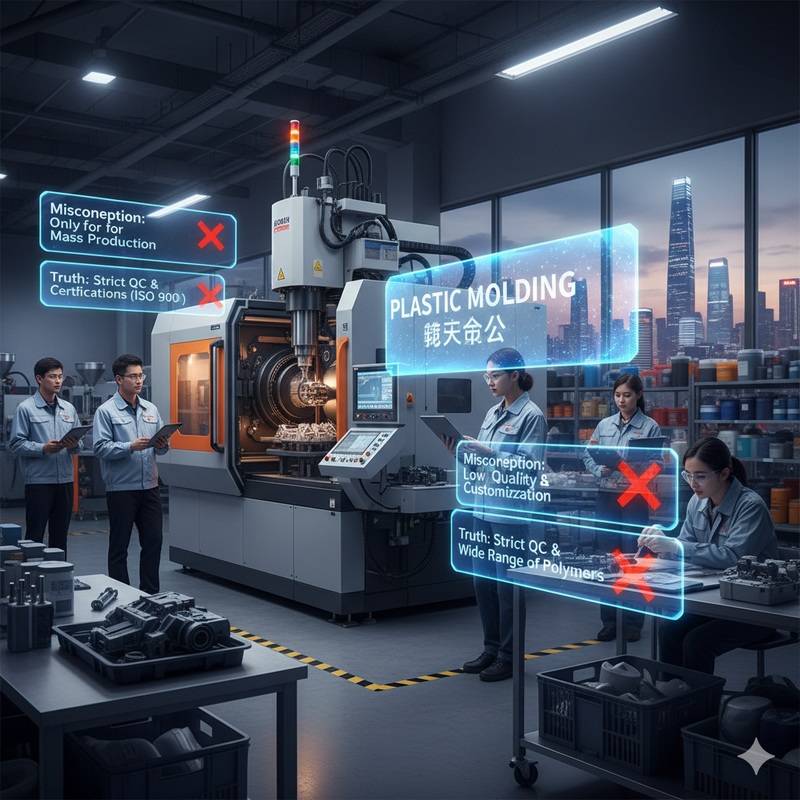Plastic molding is one of the most frequently utilized manufacturing processes! Fundamentally, it uses molds to shape plastic into desired shapes, providing businesses all around the world with versatility. However, there are so many myths around it that cause confusion. Due to misleading assumptions, many businesses exploring plastic molding in China frequently hold back. In this blog, we will address five prevalent myths, dispel them, and assist you in making wise choices.

The idea that plastic molding exclusively creates disposable or low-quality goods is a common misconception. It is not at all the case in reality. With the development of sophisticated materials and methods, plastic molding has become more useful, precise, and long-lasting. Because of their precision and durability, molded components are used extensively in industries including aerospace, medical, and automotive.
Some people believe that plastic molding is only good for simple shapes. However, intricate designs with fine details, textured surfaces, and many components in a single mold are made possible by modern molding processes. Engineers may create components that meet both practical and aesthetic needs with features like undercuts, inserts, and over-molding.
The environmental discussion is often clouded with presumptions. The molding process is not wasteful by nature, even though plastics themselves present sustainability issues. Many manufacturers today:
● Use recyclable materials
● Reprocess waste plastic
● Use energy-efficient machinery
Furthermore, cars that use lighter plastic components use less fuel, which indirectly lowers carbon emissions. Plastic molding may support environmentally responsible production with adequate planning.
The idea that only big businesses can afford plastic molding is another misconception. Even while initial tooling costs might be significant, they are frequently outweighed by long-term advantages. Cost-effective alternatives like aluminum tooling or family molds allow small firms to begin with low-volume runs. Prototypes are quicker and less expensive because of advancements in digital design, which help lower trial-and-error costs.
Some people believe that plastic molding in China has a narrow range of applications, but its versatility is exactly why it’s so popular. Molded pieces are used in everything from construction materials to consumer electronics. There are many different types of resins available to manufacturers, and each one has special qualities like flexibility, heat resistance, or transparency. Customization, branding, and even different finishes in a single product are supported by the process.
A versatile and effective technique, plastic molding continues to drive innovation in various sectors. Businesses can make smarter decisions and capture growth opportunities by debunking these widespread misunderstandings. Additionally, exploring rapid prototyping services might be the ideal first step for companies wishing to test concepts prior to full-scale manufacturing.
Which industries benefit the most from plastic molding?
Plastic molding is prevalent in the automobile, electronics, medical, aerospace, and consumer product sectors. It is also versatile, making it appropriate for both small-sized and large-sized parts.
Is plastic molding appropriate for low-volume applications?
Yes, businesses can employ processes such as aluminum tooling or family molds to make smaller batches, being cheaper yet still creating professionally finished goods.
How does plastic molding contribute to sustainability?
It supports recycling of waste plastic, the use of eco-friendly resins, and lighter componentry that reduces energy consumption during transportation.
Is high precision achievable in plastic molding?
Yes. Employing advanced tooling and technologies like over-molding, the process is capable of producing very precise parts featuring sharp details and consistent quality.
What is plastic molding's contribution to rapid prototyping?
Rapid prototyping allows businesses to test designs, functionality, as well as selections of materials ahead of high-volume production, saving time, money, and risk.